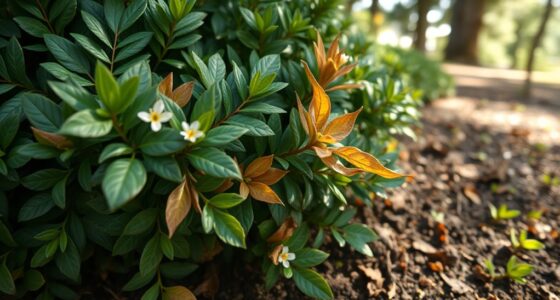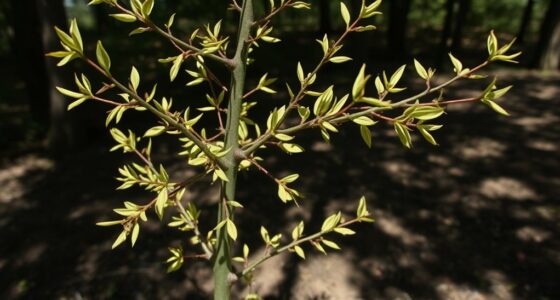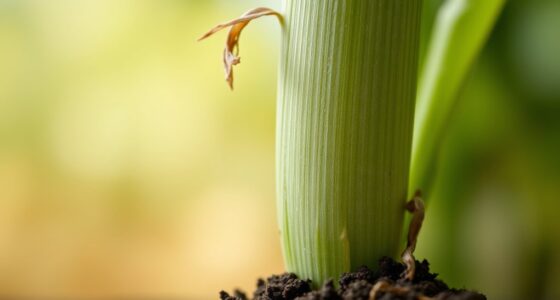Your Brunnera may be dying due to heat stress, sun scorch, or root problems like poor drainage and rot. Excess sun causes leaf damage, while over- or underwatering weakens roots and leads to disease. Pests and diseases can also drain your plant’s health. Ensuring proper watering, shade, and soil conditions is key to recovery. Keep exploring for detailed steps that can help revive your struggling plant.
Key Takeaways
- Excessive sun exposure causes leaf scorch, dehydration, and overall stress, weakening Brunnera and leading to dieback.
- Overwatering or poor drainage can cause root rot, resulting in yellowing, wilting, and plant decline.
- Underwatering leads to leaf scorch, wilting, and dehydration, especially in hot, sunny conditions.
- Pest infestations and fungal diseases damage roots and foliage, compounding health issues and causing plant death.
- Improper planting site, such as low drainage areas or too much sun, increases stress and susceptibility to damage.
Signs of Heat Stress in Brunnera

Heat stress can quickly damage Brunnera plants, especially during hot, dry spells. When your plant is under heat stress, you might notice wilting or browning leaves, signaling that it’s struggling to stay hydrated. Fungal infections can take hold more easily in stressed plants, leading to further damage. Pest infestations, like aphids or spider mites, often become a problem as plants weaken from heat, making them more vulnerable. Keep an eye out for discolored or sticky foliage, which indicates pest activity or disease. The combination of these issues can accelerate decline. Addressing heat stress early helps prevent these secondary problems. Ensure your Brunnera gets adequate water, shade, and airflow to minimize the risk of fungal infections and pest infestations. Proper care techniques can also bolster the plant’s resilience against environmental stressors. Additionally, providing shade and proper watering can significantly reduce heat-related stress and improve plant recovery, especially by understanding the signs of heat stress in plants to act promptly.
How Excess Sunlight Affects Your Brunnera

Exposing Brunnera to too much sunlight can cause significant harm to the plant’s health. Direct sun can scorch its delicate leaves, leading to wilting and discoloration. To prevent this, consider shade alternatives like placing your plant near tall trees or using shade cloths during the hottest parts of the day. Adjust your watering schedule to keep the soil consistently moist but not waterlogged, as stressed roots struggle to cope with intense sunlight. Overexposure also weakens the plant’s overall resilience, making it more susceptible to diseases. Proper color accuracy in your care routine can help you monitor changes in leaf coloration and health. By providing adequate shade and maintaining proper watering routines, you help your Brunnera stay healthy and vibrant, even in sunnier spots. Proper care guarantees it thrives without suffering from sunburn or dehydration.
Recognizing Sun Scorch and Leaf Damage

You can often spot sun scorch and leaf damage on your Brunnera by examining its foliage closely. Look for signs like foliage discoloration, which appears as yellowing or browning patches, and leaf scorch, where edges turn crispy and brown. To identify damage more precisely, check these key indicators:
Inspect foliage for discoloration and crispy, browned edges to spot sun scorch and leaf damage early.
- Uneven leaf coloration, with some areas more faded or discolored than others
- Crispy, browned leaf edges that seem to curl or dry out
- Patches of foliage that look scorched or burned, especially on leaves exposed to direct sunlight
- Overall wilting or drooping leaves that signal stress from excess sun exposure
Understanding plant stress responses can guide you in providing proper care to help your plant recover. Additionally, recognizing the effects of heat stress on your Brunnera can help prevent further damage and promote healthy growth.
The Role of Soil Moisture and Drainage

Your Brunnera needs the right soil moisture to thrive, so watering carefully is essential. Poor drainage can cause water to pool around roots, leading to root rot and plant decline. Keep an eye on moisture levels and guarantee your soil drains well to prevent stress and damage. Using a self-watering plant pot can help maintain consistent moisture levels and improve drainage, promoting healthier root development. Proper soil drainage is crucial, as it prevents excess water from lingering and creating a soggy environment that can weaken the plant’s root system. Additionally, understanding the soil composition can help optimize conditions for your Brunnera’s health.
Proper Watering Techniques
Proper watering is crucial for healthy Brunnera, and understanding soil moisture and drainage plays an essential role in this process. To maintain ideal moisture retention, you should follow a consistent watering schedule that keeps the soil evenly moist but not waterlogged. Overwatering can lead to root rot, while underwatering causes stress and leaf scorch. Here are key tips:
- Water deeply but infrequently to encourage strong roots.
- Check soil moisture regularly with your finger or a moisture meter.
- Adjust watering based on weather conditions—more during dry periods, less after rain.
- Avoid letting the soil dry out completely or stay soggy for long periods.
- Being aware of the Pinball Machine Weight can help you avoid disturbing the roots during moving or planting.
- Proper soil drainage is vital to prevent excess moisture from accumulating around the roots, which can cause problems like root rot. Additionally, maintaining good soil aeration can promote healthy root development and prevent compaction.
Following these steps helps ensure your Brunnera gets the right amount of water for healthy growth.
Soil Drainage Quality
Since soil drainage directly influences moisture levels, understanding its quality is essential for healthy Brunnera growth. The soil composition determines how well water moves through your garden bed; heavy clay soils tend to retain too much moisture, risking root rot, while sandy soils drain too quickly, causing dehydration. To improve drainage, consider amending your soil with organic matter like compost or coarse sand. Mulching techniques also help regulate moisture, preventing rapid drying or waterlogging. A layer of mulch keeps the soil evenly moist, reduces temperature fluctuations, and encourages healthy root development. Regularly assess your soil’s drainage by observing water flow after watering or rainfall. Proper soil composition combined with effective mulching creates an ideal environment for Brunnera, reducing the risk of dying caused by water-related root issues.
Moisture Level Monitoring
Monitoring soil moisture levels is essential to maintaining ideal conditions for Brunnera. Too much or too little water can stress the plant, leading to wilting or root rot. To keep moisture balanced, consider these key actions:
- Regularly check soil moisture with a simple probe or finger test.
- Use soil amendments to improve drainage in heavy or compacted soil.
- Apply mulch around the plant to retain moisture and prevent rapid drying.
- Adjust watering based on weather conditions, ensuring soil stays evenly moist, not soggy or dry.
- Incorporate low light office plants into your gardening space to create a calming environment that supports plant health.
Common Root Problems and Their Impact

You might notice your Brunnera showing signs of root rot, like wilting or yellowing leaves, which indicate damaged roots. Poor soil drainage often contributes to this problem, causing roots to stay wet and decay. Addressing drainage issues quickly can help protect your plant from further root damage. Additionally, ensuring proper local soil conditions can prevent excess moisture buildup that leads to root problems. Incorporating mindful gardening practices can further reduce the risk of such issues. Implementing Volkswagen Tuning techniques, such as improving engine airflow and optimizing engine maps, can also enhance your vehicle’s overall performance and longevity.
Root Rot Signs
How can you tell if your Brunnera is suffering from root rot? Look for signs like yellowing leaves, wilting despite watering, and a foul smell around the base. Root rot occurs when soil drainage is poor, causing roots to sit in waterlogged soil and decay. To identify it early, gently remove the plant from its pot or inspect the base in the ground. Watch for these key indicators:
- Soft, blackened roots when you gently pull back soil.
- Leaves that turn yellow and droop unexpectedly.
- A musty or rotting odor near the roots.
- Stunted growth or failure to thrive despite proper care.
- Understanding proper soil drainage techniques can help prevent future issues. Additionally, recognizing the importance of soil aeration can improve root health and prevent waterlogging. Ensuring good soil drainage promotes healthier roots and minimizes the risk of decay. Quick action can save your Brunnera; however, improving soil drainage is essential to prevent further root rot issues.
Soil Drainage Issues
Poor soil drainage is a leading cause of root problems in Brunnera, as it allows excess water to linger around the roots. When the soil stays too wet, it can lead to root rot and weaken the plant’s overall health. To prevent this, consider improving your soil with a proper soil amendment that enhances drainage. Incorporating companion planting with plants that tolerate wet conditions can also help balance moisture levels and protect your Brunnera. Make sure the planting site isn’t low-lying or prone to water pooling. Good drainage promotes healthy roots and prevents fungal issues. Regularly check soil moisture and adjust your planting strategy accordingly, ensuring your Brunnera has the well-draining environment it needs to thrive.
Overwatering and Underwatering Consequences

Overwatering and underwatering can both have serious effects on Brunnera health, often leading to its decline if not carefully managed. Inconsistent watering habits disrupt soil moisture levels, causing stress to the plant. Too much water drowns roots, leading to root rot and yellowing leaves. Conversely, too little water causes dehydration, wilting, and leaf scorch. To prevent this, monitor soil moisture frequently and water only when the top inch feels dry. Keep in mind:
Consistent watering prevents root rot, leaf scorch, and promotes healthy Brunnera growth.
- Overwatering leads to root rot and fungal issues
- Underwatering causes leaf scorch and wilting
- Excess moisture suffocates roots, inhibiting nutrient uptake
- Insufficient watering stresses the plant, reducing growth
- Proper watering practices support overall plant health and resilience, especially when managing environmental factors like soil quality and light conditions.
Maintaining balanced watering habits is essential for healthy Brunnera growth.
Identifying Pests and Diseases That Weaken Roots

Pests and diseases can silently weaken your Brunnera’s roots, making the plant more susceptible to decline. Pest identification is essential; look for signs like tiny insects, sticky residue, or chewed leaves. Common pests include aphids, slugs, and vine weevils, which attack roots or stems, causing stress. Diseases such as root rot or fungal infections can also impair root health, often indicated by discolored or rotting roots. To prevent these issues, practice disease prevention by ensuring good drainage, removing infected plant material, and avoiding overhead watering that fosters fungal growth. Regularly inspecting your plant helps catch problems early, so you can take action before pests or diseases cause irreversible damage. Staying vigilant is key to maintaining healthy, resilient roots.
Proper Planting and Care to Prevent Decline

Ensuring your Brunnera thrives starts with proper planting and ongoing care. To prevent decline, focus on key practices. First, choose a shady or partially shaded spot to protect it from heat and sun scorch. Second, use correct pruning techniques by removing dead or damaged leaves to promote healthy growth. Third, apply fertilizer in early spring with a balanced, slow-release formula to support vibrant foliage. Fourth, guarantee well-draining soil to prevent root rot. Regular watering keeps the soil moist but not soggy. Proper planting depth and spacing are vital. By following these steps, you minimize stress factors that weaken your plant, helping it stay lush and healthy longer.
Steps to Revive a Struggling Brunnera

If your Brunnera is struggling, acting quickly can help revive its health. First, remove any damaged or dead leaves to improve airflow and reduce disease risk. Apply a balanced fertilizer to provide essential nutrients that promote vigorous growth. Be careful not to over-fertilize, as this can cause further stress. Consider companion planting with shade-loving plants like hostas or ferns to shield your Brunnera from harsh sun and heat, creating a more suitable environment. Guarantee the soil is moist but well-draining, and water deeply whenever it feels dry. Mulch around the plant to retain moisture and regulate soil temperature. Regularly monitor for pests or signs of root distress, and adjust your care routine accordingly to help your Brunnera recover.
Frequently Asked Questions
Can Improper Watering Cause Long-Term Root Damage in Brunnera?
Improper watering can definitely cause long-term root damage in your Brunnera. Overwatering leads to soggy soil, which suffocates roots and promotes rot, while underwatering causes dehydration and stress. Both watering issues weaken the root system, impairing nutrient uptake and overall health. If root damage occurs, it can be difficult for your plant to recover, so maintaining consistent, appropriate watering is vital for keeping your Brunnera healthy.
How Does Soil Ph Affect Brunnera’s Health and Resilience?
You should pay attention to your Brunnera’s soil pH because soil acidity and pH balance directly impact its health. If the soil is too acidic or alkaline, it can hinder nutrient uptake, making the plant weak and more susceptible to damage. Aim for a neutral pH around 6.0 to 7.0. Regularly test your soil and amend it as needed to maintain ideal pH balance, ensuring your Brunnera thrives.
Are There Specific Fertilizers That Prevent Heat and Sun Stress?
You might think fertilizers alone can prevent heat and sun stress, but they’re just part of the solution. Look for fertilizer choices that strengthen your Brunnera’s root system and promote overall resilience. Combine this with effective sun protection—like shading or mulching—to shield it from scorching rays. This dual approach helps your plant withstand stress, keeping it healthy and vibrant despite challenging weather conditions.
What Are Less Obvious Signs of Root Rot in Brunnera?
You might notice less obvious signs of root rot in your Brunnera, like foliage discoloration or unusual leaf curling. These symptoms often appear before more obvious dieback, signaling trouble below the surface. If your plant’s leaves change color or curl without clear reason, it could be due to compromised roots. Check the soil for sogginess and smell for decay—early detection helps save your plant.
How Does Plant Placement Influence Susceptibility to Root and Heat Issues?
Your plant placement and sun exposure directly influence its health. If you position your Brunnera in full sun or areas with intense heat, it becomes more susceptible to heat stress and sun scorch. Conversely, placing it in partial shade helps protect against these issues and promotes healthy root development. make certain it’s not too close to heat-reflecting surfaces, which can intensify sun exposure and root problems. Proper placement is key to keeping your plant thriving.
Conclusion
So, if your Brunnera’s throwing a tantrum—shriveling, scorching, or sulking in the soil—don’t just stand there in denial. Check the sun, water it wisely, and give those roots some love. After all, it’s not asking for much—just a little shade, proper drainage, and maybe a kind word. With patience and a bit of gardening finesse, your plant can bounce back, proving even the most dramatic foliage is just seeking a little TLC.









